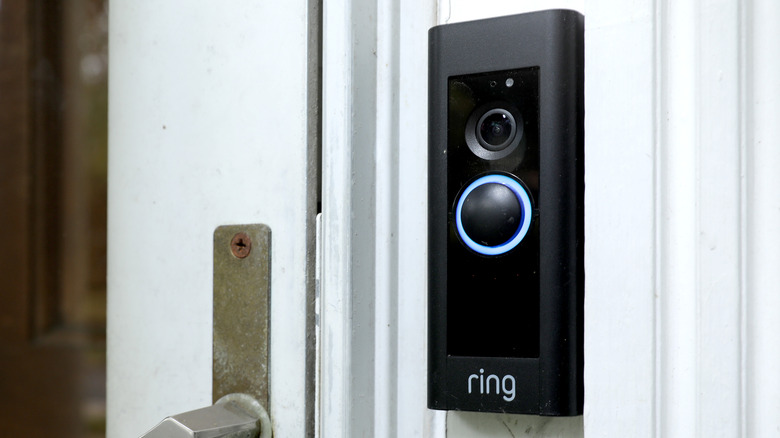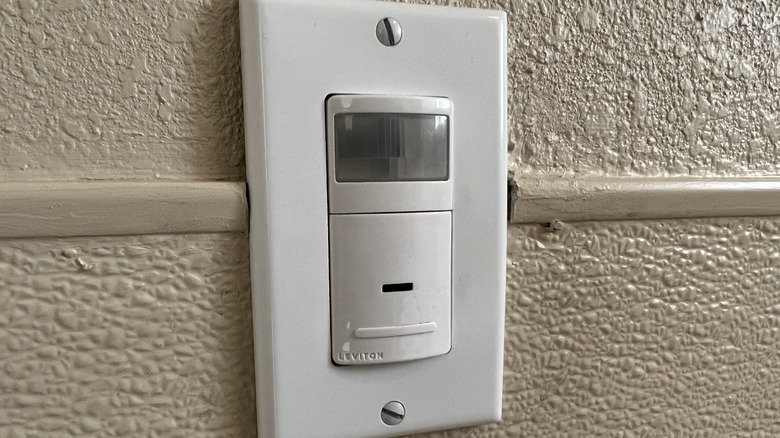The Biggest Complaints Ring Camera Owners Have About The Video Doorbell
Outside of devices that go everywhere with you, like your smartphone or smartwatch, there are few pieces of technology more deeply personal than video doorbells from the likes of Ring and its competitors. Able to be used on their own or as part of a larger security system, these doorbell cameras add a layer of surveillance to the average neighborhood that wasn't there before.
For some, the Ring Video Doorbell is a step forward for not just home security but also personal convenience. Ring and other video doorbells are far from perfect, though. From several major privacy issues that have embarrassed the company to technical issues and feature changes that disrupt its functionality, Ring Video Doorbell owners have had to deal with some frustrations in navigating the devices. Let's take a look at a few of the biggest concerns that have popped up among Ring owners and, when applicable, how Ring has addressed each of them.
Requiring a paid subscription for previously free features
In early 2023, Ring made some headlines by announcing — albeit in an update to its support pages — that various features that had previously been included with the purchase of a video doorbell were being moved over to the paid Ring Protect subscription plans. "Starting March 29, 2023, a Ring Protect subscription is required to access Ring Alarm in-app features in the U.S. and Canada, including digital notifications and the ability to Arm and Disarm from your app," read the announcement. "If you owned an Alarm before this date, your current device will keep these in-app features. If you did not own an Alarm, these features will now require a subscription."
For those with the basic video doorbells but not the Ring Alarm hardware, this means that they lost the ability to set "home" and "away" modes to alter the behavior of their Ring Video Doorbells. This determines how strictly movement is scrutinized inside vs. outside the home, and though it was free before, it now requires a subscription. Those subscriptions start at $3.99 per month or $39.99 per year if paid in an annual lump sum.
What all of this means is that a lot of features that made Ring Video Doorbells relatively inexpensive home security systems have gotten a lot more expensive. If you had one of the doorbells before March 29, you lost a lot of features that you thought you had already paid for, even while existing Ring Alarm owners didn't lose any features. Now? Without a subscription, a Ring Video Doorbell is literally just that: A live video doorbell.
Faulty motion detection
One common complaint from Ring Video Doorbell owners about the basic functionality of the device is that its motion detection features don't work reliably. In theory, this is something that you should be able to fix by adjusting the motion sensitivity, but in practice, that's easier said than done.
These complaints often appear to be about false positives from the motion detection being oversensitive. (And not just on the video doorbells. It happens enough with Ring's standalone motion detectors that the company has a support page for correcting the problem on those specifically, giving mainly common-sense advice for the problem.)
"I live where it's gray much of the year," reads one support forum post from April 2023. "My [R]ing doorbell motion sensor works great in the winter, only triggering when someone actually approaches the door. In the summer, all bets are off. This is one of our first warm, sunny days, and the sensor has been triggering every 4–6 minutes." In response, a Ring representative explained that false alerts can be caused by "moving trees, the rising or setting sun, reflections off a shiny object, headlights, shadows, and more.
Other Ring Video Doorbell owners have had the opposite problem, with one who posted a review on SiteJabber saying it missed a home invasion. "I'd like to know why it picks up everything except a kid in a mask kicking in a door in a hate crime," she wrote. "Picked up him leaving. But not walking up the steps or kicking it in."
They're a privacy nightmare
Starting in 2019, stemming from reports of misconduct at Ring's Ukrainian office, the world learned that Ring employees could watch their personal videos from their Ring Video Doorbells and even in-house cameras. Though Ring denied that this was happening with anything other than cases where the customer had given explicit permission, multiple sources who spoke to The Intercept told the outlet that this was a lie.
More specifically, sources told reporter Dani Deahl that "the company provided its R&D team in Ukraine with virtually unrestricted access to a folder on the company's Amazon's S3 cloud storage instance containing every Ring customer video" and that American Ring executives and engineers had "unfiltered, round-the-clock live feeds from some customer cameras."
In January 2020, that was followed up by Ring sending a letter to multiple U.S. Senators who had expressed their concerns, in which the company admitted that it had fired employees for improper usage of video data. A few years later, in May 2023, the Federal Trade Commission sued Ring for these privacy issues. The government agency is seeking monetary damages and injunctive relief, meaning that the FTC is trying to push for the judge to issue an order compelling certain changes from Ring.



